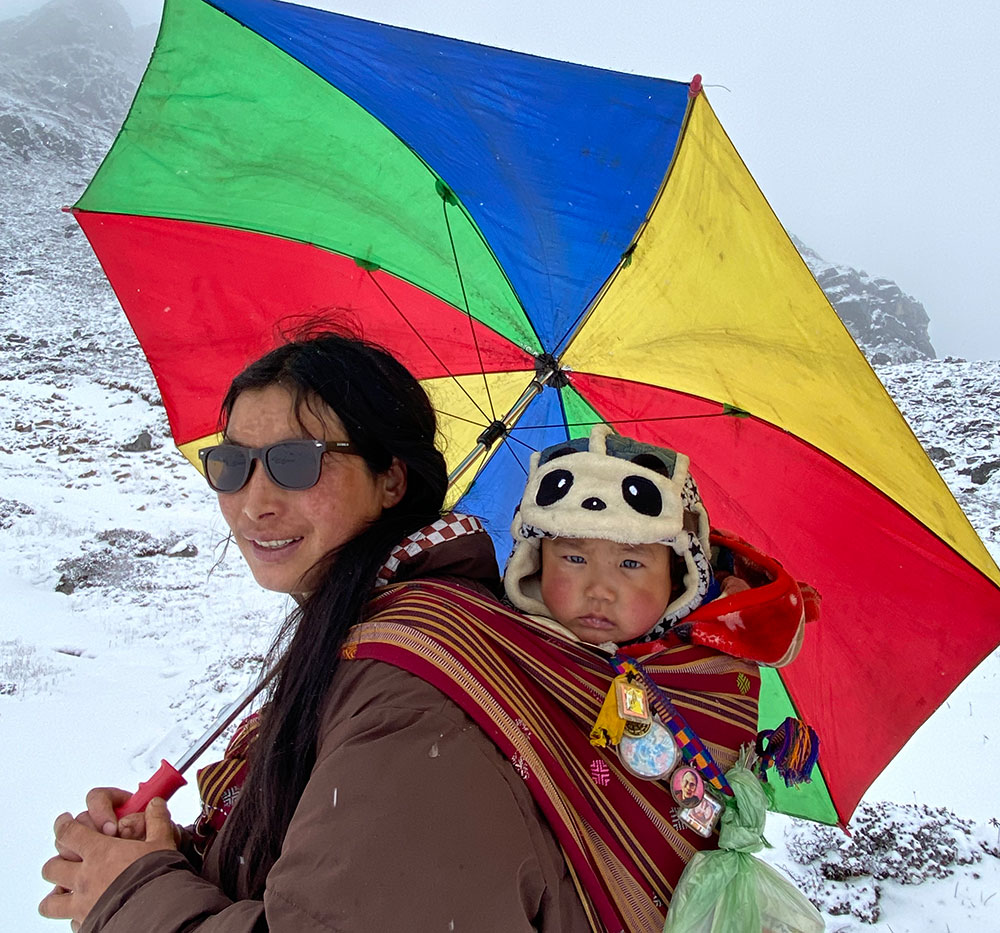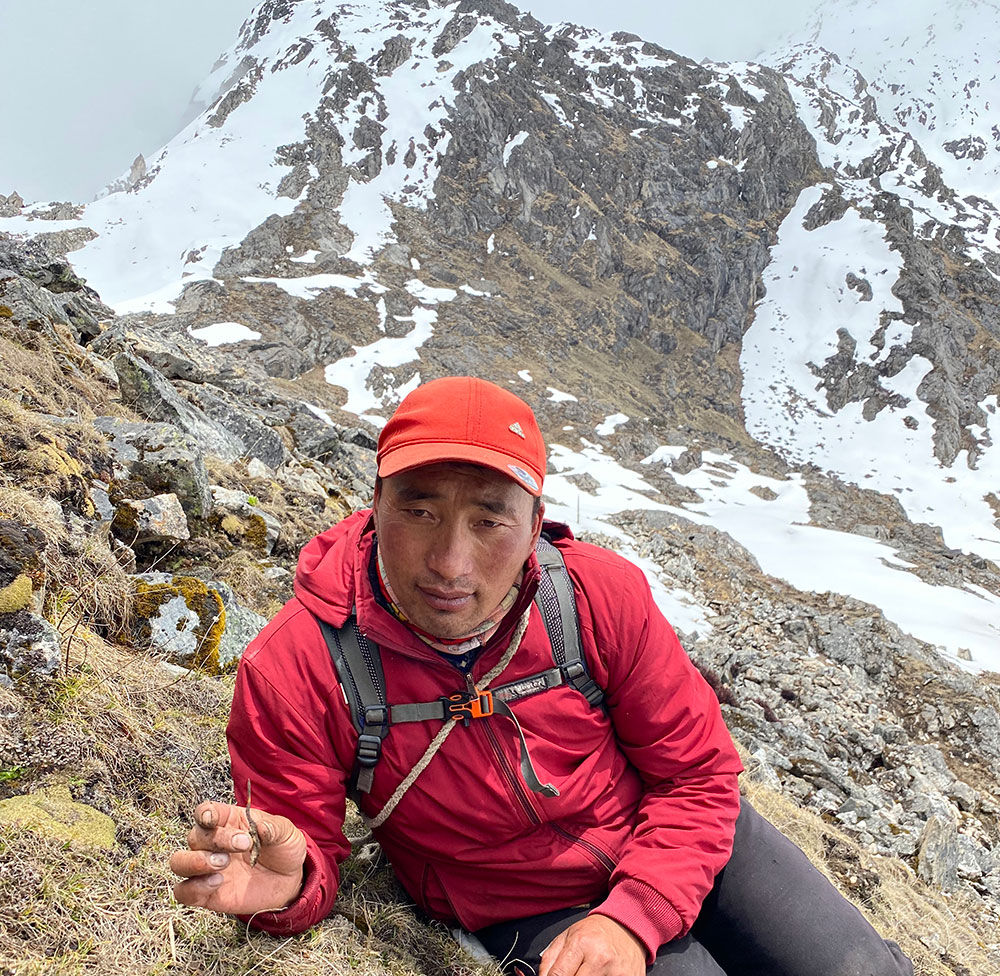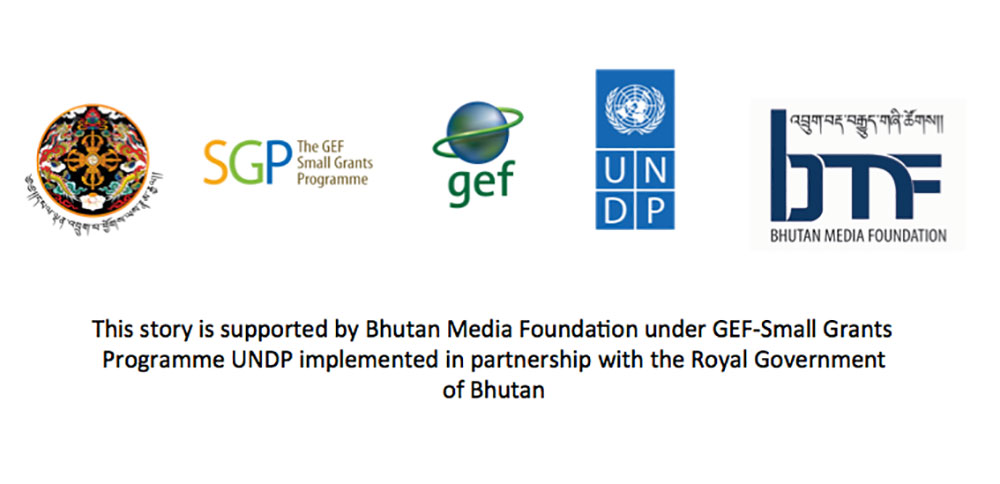Choki Wangmo
Gumna, Laya—It is late in the afternoon, when hours after descending a steep and dangerous cairn, glistening with layers of snow, the majestic Masangang came into view. A crisp mountain air cut through the silent vast land as the strong breeze gracefully encircled the towering peaks. A lone woman with a child strapped on her back, trudges towards the campsite, a stark figure amidst the snow-white landscape.
Chimi Dema, with her 9-month-old grandson, Tandin Sonam is returning to the campsite with their day’s harvest of cordyceps. “It is just a single piece,” she said with a frown. Early that morning, the duo left their campsite at Gumna, the base of the Masangang range to look for yartsa guenbup which has become extremely rare in recent years.
Chimi’s daughter, Sonam Wangmo, along with more than 20 highlanders from Lungo in Laya left for the higher peaks with high hopes of a better harvest. Since its legalisation in 2004, for a month every year, people in the mountains of 15 gewogs in Bhutan make a tortuous and cumbersome journey, scaling above 4,000 and 5,000 metres looking for the “Himalayan Gold”.
Once in the uncertain alpine mountains, they spend most of their time crawling on the ground, trying to collect cordyceps among other grasses. The conditions are harsh— treacherous routes, freezing winds, rain, bloodshot eyes, strong ultraviolet rays, low oxygen, migraines, and altitude sickness. There are no guarantees that they will find anything at the end of a month after braving such hardships in the mountains.


The risk of death and brawls among other collectors hangs heavy. People had died for the internationally sought-after aphrodisiac, Ophiocordyceps sinensis. The most recent incident in Tsharijathang in 2021 is still fresh in their memories.
Pem Zam from Lungo is still haunted by the memories of her 10 friends who were buried under a landslide in 2021 at Tsharijathang as she watched in horror. She camps below a glacial lake; her nights are disturbed by thoughts of dying in an outburst flood or snow avalanches.
But in the evening, she sits by the fire in her wobbly tarpaulin tent. The silent fall of the snow is loud as the eerie night sets in. She digs into her pockets and starts counting her day’s harvest. She got 10 pieces. As she put cordyceps into a plastic jar, she smiled, “It is my lucky day.”
Her friends, who climbed higher than Masangang, returned with a few pieces of cordyceps, and a throbbing migraine.
Three decades ago, Pem Zam’s 62-year-old father Rinchen Tashi collected a bag full of cordyceps in one sitting. As the fungus did not have any commercial value, they would collect only a few for self-consumption. As the four members of his family return with a mere harvest after a month in the mountains, he is in disbelief. This year, the harvest will be poorer, he said. Untimely snowfall is an indication, the village astrologer said.
Records show that Laya has experienced a decline in the abundance and quality of cordyceps in recent years. The amount auctioned at the forest range within the Jigme Dorji National Park showed a decreasing trend—from 55.93kg in 2020 to 38.06kg in 2021.
Climate change, characterised by fluctuating temperatures and unpredictable weather patterns, is believed to have disrupted the growth and development of cordyceps. As mountain areas are expected to experience a further increased temperature rise, their main source of livelihood is in jeopardy.
A conservation biologist, Lhendup Tharchen, says that such extreme weather conditions due to a changing climate will have an adverse impact on the highland communities. Climate change, he said, will impact the growth of cordyceps. “Cordyceps is a caterpillar fungus, and the humidity and the moisture availability will certainly favour the growth. An increase in temperature will have a huge impact on cordyceps as both the host fungi growth and the life cycle of the moth will be affected.”
This has become a rampant phenomenon across the Himalayan communities in India, Nepal, and China. A research study conducted by Stanford University reported a significant decline in cordyceps collected— in Nepal, the production per person significantly dropped from 212-261 pieces in 2006 to 97-126 in 2010, while China experienced a substantial 70 percent decline in yield from 1978 to 2001.
Unsustainable collection, ecosystem disturbance, and climate change, the research says, had caused the rapid decline.
The snowfall in May this year was heavy in Laya. This had affected the cordyceps growth, as most of the fungus were left to rot in the deep snows. If Laya receives heavy snowfall in February, a “normal snowfall time”, the harvest, it is said, would be good. Due to erratic weather conditions—heavy rain and snow—Pem Zam and her friends stay in tents for most of the days during the collection period. They occasionally go outside to check the weather.
The cordyceps collection, which was once a masculine task has become a lucrative job for everyone in the household. A household can get three permits issued by the gewog administration. But there are many who leave behind their children and elderly parents in the villages as they leave for the mountains in hopes of even obtaining a piece of the highly-priced fungus.
Pem Lhaden, 50, had been collecting cordyceps for the past 15 years. This year, she walked half a day to Gumna from Lungo with her husband and the youngest son to collect the cordyceps. Her three other children and their families had spread across various collecting areas in Laya Gewog. Her five-year-old granddaughter is left in the care of the early childhood care and development centre in Laya.
“We used to collect 500 pieces a day two decades ago,” Pem Lhaden recalls. Now the highest amount one can collect in a day is 50, that too, when the harvest is good, which is every four years. Last year, it was a lucky year for them. The harvest was good, with a record price of Nu 2.85 million for a kg at the auction yards.
“It is like a gamble; it depends on luck. The times are difficult now, snowfall has decreased too,” the mother of four said, as she pointed at a receding snowline along the Raena-gu Mountain range. “The snow used to reach till the base. Now it is just rocks.”
The mountain gold has helped attract many dropout youths in the highlands. Tshering Yangden, a middle school dropout climbs as high as 5,000 metres to collect cordyceps. She takes noodle seasonings and sweets to counter mountain sickness. She is planning to head to Lunana, about a three day’s hike away from Lungo. It is located at a higher altitude but the group of young people wants a better harvest.
While her mother goes to collect the cordyceps, Karma Yuden,8, tends to her two-year-old brother in the tent. She had to drop out of school after completing class I when her parents separated years ago.
Pem Zam left behind her ageing parents and 84-year-old mother-in-law with dementia in Lungo. Her two children are in boarding schools in Gasa. Occasionally for an hour, she climbs a pass with a cellular network to ask after them.
Times are difficult for women. Maintaining hygiene in such cold weather is almost impossible. Days are hard with monthly periods and premenstrual symptoms.
Tshewang Lhamo, a Gender and Inclusion Analyst with the United Nations Development Programme, said that caregiving and domestic responsibilities will have a huge bearing on women’s health and wellbeing. As they don’t have time for leisure to take care of the physical and mental stress, they are vulnerable to disaster and climate change impacts. “The impact of these stresses is more for women cordyceps collectors due to harsh climatic and geographical conditions.”
After three days at Gumna, Chimi Dema returned home to Lungo with her grandson and her youngest daughter. Her sick daughter was suffering from frequent asthma attacks.
“People say mountain people are rich from cordyceps business, but only if they know a portion of what we go through, no one will dare say it again!” the 38-year-old said, with a look of defeat on her weather-beaten face.



